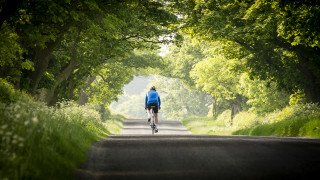Whether you're grinding gravel on a bikepacking trip, chasing a personal best at your local time trial, tackling a sunny training camp abroad, or just enjoying a spin on your local trails, time in the saddle is always better with the sun on your back.
But from road, track, and mountain biking to family rides and holidays, cyclists across all disciplines spend long hours outside, often with large areas of skin exposed. That puts you at risk of sunburn, skin damage and, over time, more serious health issues.
To help you ride smarter in the sun, we spoke to keen cyclist and expert dermatologist Professor Brian Diffey from the British Association of Dermatologists.
Why is sun protection especially important for cyclists?
Cyclists tend to be outdoors for long periods, with exposed skin and little natural shade. That means a greater risk of sun damage, and we know from research that regular exposure increases the chances of developing skin cancer later in life.
We’re often told to avoid being outside between 11am and 3pm, when the sun is strongest. But that's not always practical for cyclists heading out on a big ride. What can they do?
Check the UV forecast before you head out, especially in summer. If the UV rating is high, consider adjusting your ride time. Going out earlier still gives you several hours of good riding, and waiting until later in the day is also an option.
If changing your ride time isn’t feasible, it’s essential to wear high-quality sun protection, particularly sunscreen, and reapply it regularly throughout your ride.
What should cyclists look for in a sunscreen?
Choose a sunscreen with:
- SPF 30 or higher
- Good UVA protection
The UVA star system is the UK's most common UVA labelling. Look for four or five stars. You may also see the UVA logo, which was approved by the EU, which means the product offers balanced UVA and UVB protection.

Most sunscreens offer this, but it’s worth checking the label to be sure.
Any tips for applying sunscreen correctly before a ride?
Yes, apply it 15 to 30 minutes before going outside. Spread it evenly over exposed areas, but don’t rub it too aggressively. Let it dry fully before you get dressed or start sweating.
Then, continue reapplying during your ride, especially if you’re sweating heavily.
How often should cyclists reapply sunscreen while riding?
Reapply every two hours at a minimum. But if you sweat a lot or wipe your face often, you may need to do it more frequently.
Also, avoid relying on ‘all-day’ or ‘extended wear’ sunscreens. Even the best of them can still be wiped off or sweat away.
What about your head? Is there any risk of burning through helmet vents?
If your hair is thinning or your scalp is exposed through helmet vents, you’re at risk of burning, which is often overlooked.
If applying sunscreen to your scalp isn’t practical, consider wearing a casquette or bandana under your helmet to act as a physical barrier.
Some cyclists wear their tan lines with pride. Can tanning ever be safe?
There’s no such thing as a completely safe tan. Tanning happens when UV rays damage your skin, which responds by producing more melanin to try to protect itself.
If you’re wearing sunscreen and still tan, that’s better than tanning without protection -but it’s still a sign that damage is happening.
The key is to avoid sunburn at all costs. The damage becomes much more severe when the skin is exposed to sunlight.
If I do get sunburnt, what’s the best way to treat it?
There’s no real cure for sunburn, only symptom relief. Once the skin is damaged, it can’t be reversed. Use soothing moisturisers, like calamine lotion, to ease the discomfort, and take anti-inflammatories if needed to help with pain and redness. After that, it’s a waiting game - and a reminder to be more cautious next time.
What signs of skin damage should cyclists look out for?
Check your skin once a month, especially areas that get a lot of sun exposure.
Look out for:
- New lumps, spots, or moles that weren’t there before
- Changes in shape, colour, texture or size of existing moles
- Sores that don’t heal
- Patches that are itchy, painful or bleed
It’s a good idea to photograph any mole you want to monitor and use something like a coin for scale. That way, you’ll notice if anything changes. If you’re ever unsure, see your GP. Don’t take chances.
Whether training, racing, or just riding for fun, protecting your skin should be part of your routine, just like checking your tyres or filling your bottles. A few simple habits around sun safety can help you enjoy your time on the bike now and protect your health for the long term.
This article has been written in collaboration with the British Association of Dermatologists, which will run its annual Sun Awareness Week from 12 to 18 May 2025. For more information, please visit www.skinhealthinfo.org.uk.





